Nursing Assignment: Pressure Ulcer Prevention and Management
VerifiedAdded on 2020/04/21
|5
|1251
|159
Report
AI Summary
This nursing assignment report focuses on the critical healthcare issue of pressure ulcers (PUs) in aged care facilities, specifically addressing the vulnerable elderly population. It emphasizes the importance of risk assessment, prevention, and management strategies undertaken by nurses. The report highlights the use of risk assessment scales like the Braden scale, and discusses various risk factors such as skin integrity, mobility, and nutritional status. It summarizes key studies, including a quantitative retrospective cohort study by Tescher et al., (2012) that found the Braden scale and its subscales to be highly predictive for PU risk assessment. The report also discusses the effectiveness of repositioning and skin care in PU prevention, citing studies by Moore, Cowman & Posnett, (2013) and LeBlanc et al., (2013). The report concludes by emphasizing the need for continuous skin inspection, maintaining skin hydration, and nutritional assessment to improve pressure tolerance levels. The provided references offer relevant information about PU prevalence, prevention, and management strategies in the aged care setting.
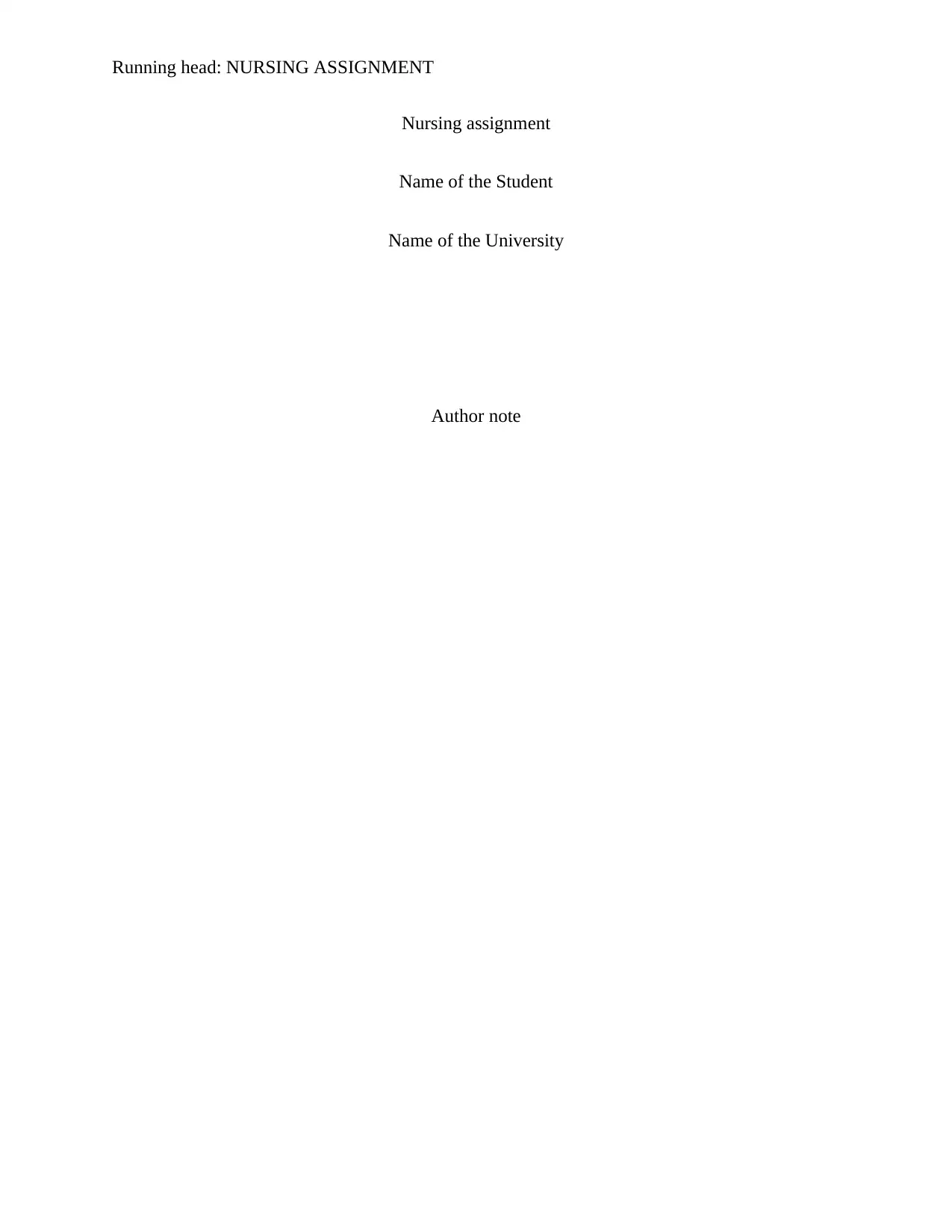
Running head: NURSING ASSIGNMENT
Nursing assignment
Name of the Student
Name of the University
Author note
Nursing assignment
Name of the Student
Name of the University
Author note
Paraphrase This Document
Need a fresh take? Get an instant paraphrase of this document with our AI Paraphraser
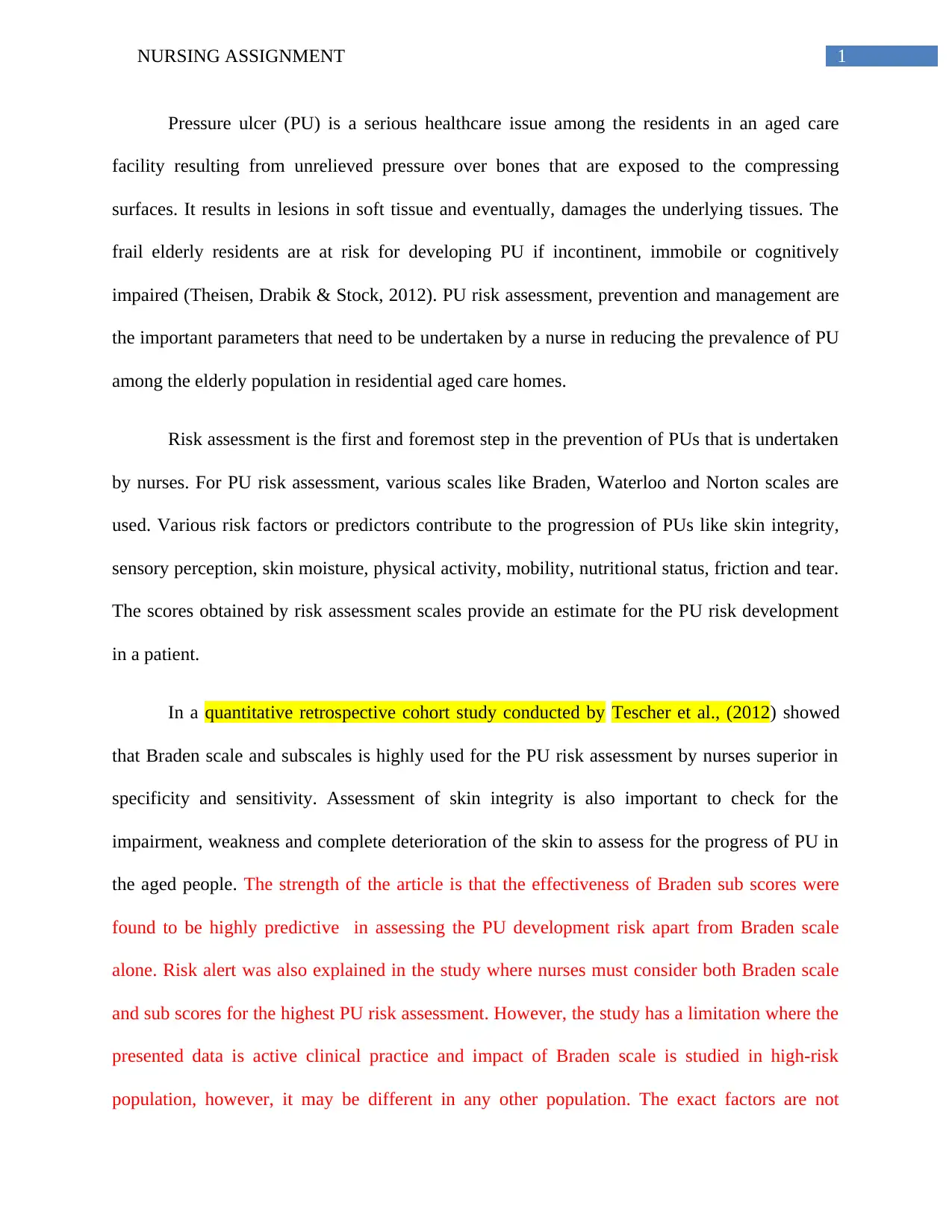
1NURSING ASSIGNMENT
Pressure ulcer (PU) is a serious healthcare issue among the residents in an aged care
facility resulting from unrelieved pressure over bones that are exposed to the compressing
surfaces. It results in lesions in soft tissue and eventually, damages the underlying tissues. The
frail elderly residents are at risk for developing PU if incontinent, immobile or cognitively
impaired (Theisen, Drabik & Stock, 2012). PU risk assessment, prevention and management are
the important parameters that need to be undertaken by a nurse in reducing the prevalence of PU
among the elderly population in residential aged care homes.
Risk assessment is the first and foremost step in the prevention of PUs that is undertaken
by nurses. For PU risk assessment, various scales like Braden, Waterloo and Norton scales are
used. Various risk factors or predictors contribute to the progression of PUs like skin integrity,
sensory perception, skin moisture, physical activity, mobility, nutritional status, friction and tear.
The scores obtained by risk assessment scales provide an estimate for the PU risk development
in a patient.
In a quantitative retrospective cohort study conducted by Tescher et al., (2012) showed
that Braden scale and subscales is highly used for the PU risk assessment by nurses superior in
specificity and sensitivity. Assessment of skin integrity is also important to check for the
impairment, weakness and complete deterioration of the skin to assess for the progress of PU in
the aged people. The strength of the article is that the effectiveness of Braden sub scores were
found to be highly predictive in assessing the PU development risk apart from Braden scale
alone. Risk alert was also explained in the study where nurses must consider both Braden scale
and sub scores for the highest PU risk assessment. However, the study has a limitation where the
presented data is active clinical practice and impact of Braden scale is studied in high-risk
population, however, it may be different in any other population. The exact factors are not
Pressure ulcer (PU) is a serious healthcare issue among the residents in an aged care
facility resulting from unrelieved pressure over bones that are exposed to the compressing
surfaces. It results in lesions in soft tissue and eventually, damages the underlying tissues. The
frail elderly residents are at risk for developing PU if incontinent, immobile or cognitively
impaired (Theisen, Drabik & Stock, 2012). PU risk assessment, prevention and management are
the important parameters that need to be undertaken by a nurse in reducing the prevalence of PU
among the elderly population in residential aged care homes.
Risk assessment is the first and foremost step in the prevention of PUs that is undertaken
by nurses. For PU risk assessment, various scales like Braden, Waterloo and Norton scales are
used. Various risk factors or predictors contribute to the progression of PUs like skin integrity,
sensory perception, skin moisture, physical activity, mobility, nutritional status, friction and tear.
The scores obtained by risk assessment scales provide an estimate for the PU risk development
in a patient.
In a quantitative retrospective cohort study conducted by Tescher et al., (2012) showed
that Braden scale and subscales is highly used for the PU risk assessment by nurses superior in
specificity and sensitivity. Assessment of skin integrity is also important to check for the
impairment, weakness and complete deterioration of the skin to assess for the progress of PU in
the aged people. The strength of the article is that the effectiveness of Braden sub scores were
found to be highly predictive in assessing the PU development risk apart from Braden scale
alone. Risk alert was also explained in the study where nurses must consider both Braden scale
and sub scores for the highest PU risk assessment. However, the study has a limitation where the
presented data is active clinical practice and impact of Braden scale is studied in high-risk
population, however, it may be different in any other population. The exact factors are not
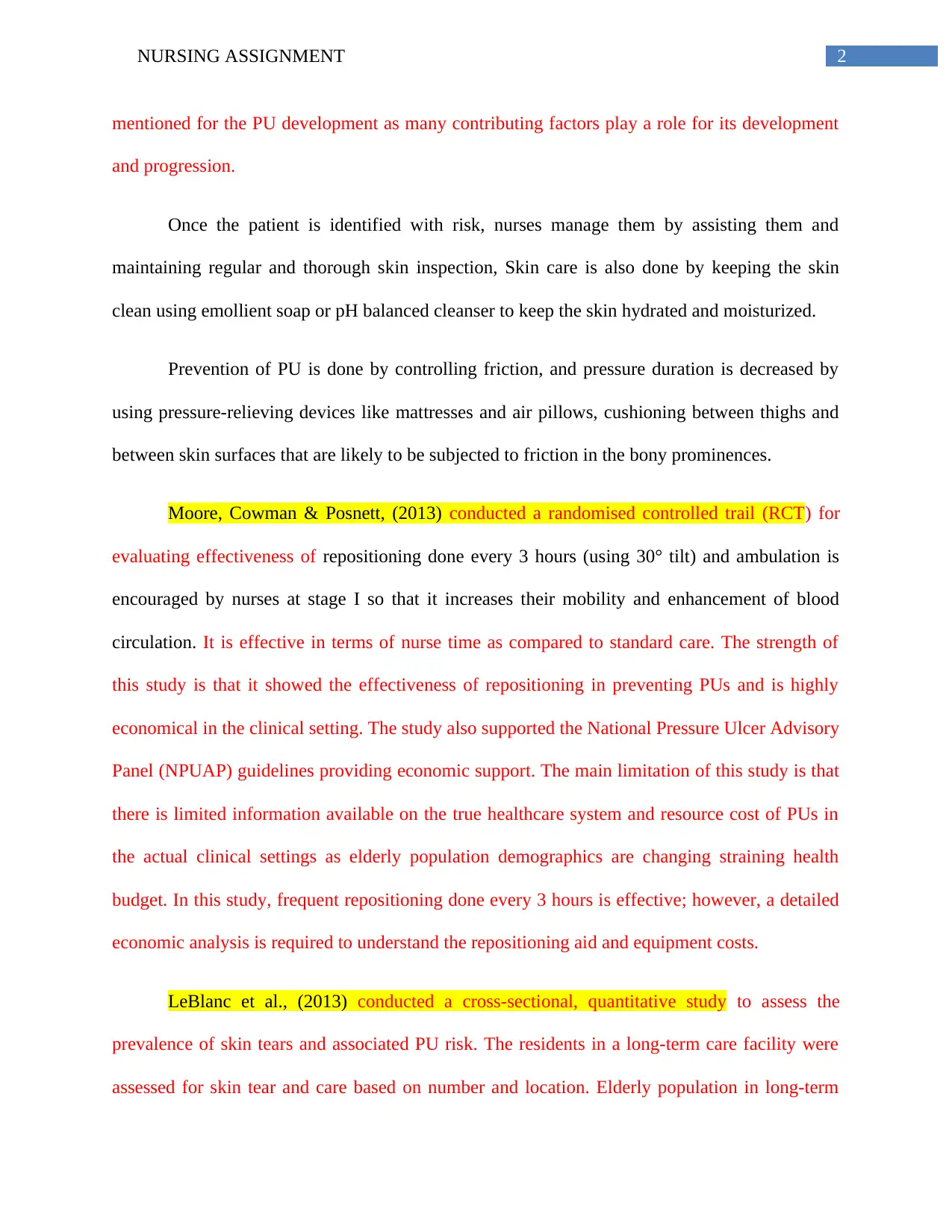
2NURSING ASSIGNMENT
mentioned for the PU development as many contributing factors play a role for its development
and progression.
Once the patient is identified with risk, nurses manage them by assisting them and
maintaining regular and thorough skin inspection, Skin care is also done by keeping the skin
clean using emollient soap or pH balanced cleanser to keep the skin hydrated and moisturized.
Prevention of PU is done by controlling friction, and pressure duration is decreased by
using pressure-relieving devices like mattresses and air pillows, cushioning between thighs and
between skin surfaces that are likely to be subjected to friction in the bony prominences.
Moore, Cowman & Posnett, (2013) conducted a randomised controlled trail (RCT) for
evaluating effectiveness of repositioning done every 3 hours (using 30° tilt) and ambulation is
encouraged by nurses at stage I so that it increases their mobility and enhancement of blood
circulation. It is effective in terms of nurse time as compared to standard care. The strength of
this study is that it showed the effectiveness of repositioning in preventing PUs and is highly
economical in the clinical setting. The study also supported the National Pressure Ulcer Advisory
Panel (NPUAP) guidelines providing economic support. The main limitation of this study is that
there is limited information available on the true healthcare system and resource cost of PUs in
the actual clinical settings as elderly population demographics are changing straining health
budget. In this study, frequent repositioning done every 3 hours is effective; however, a detailed
economic analysis is required to understand the repositioning aid and equipment costs.
LeBlanc et al., (2013) conducted a cross-sectional, quantitative study to assess the
prevalence of skin tears and associated PU risk. The residents in a long-term care facility were
assessed for skin tear and care based on number and location. Elderly population in long-term
mentioned for the PU development as many contributing factors play a role for its development
and progression.
Once the patient is identified with risk, nurses manage them by assisting them and
maintaining regular and thorough skin inspection, Skin care is also done by keeping the skin
clean using emollient soap or pH balanced cleanser to keep the skin hydrated and moisturized.
Prevention of PU is done by controlling friction, and pressure duration is decreased by
using pressure-relieving devices like mattresses and air pillows, cushioning between thighs and
between skin surfaces that are likely to be subjected to friction in the bony prominences.
Moore, Cowman & Posnett, (2013) conducted a randomised controlled trail (RCT) for
evaluating effectiveness of repositioning done every 3 hours (using 30° tilt) and ambulation is
encouraged by nurses at stage I so that it increases their mobility and enhancement of blood
circulation. It is effective in terms of nurse time as compared to standard care. The strength of
this study is that it showed the effectiveness of repositioning in preventing PUs and is highly
economical in the clinical setting. The study also supported the National Pressure Ulcer Advisory
Panel (NPUAP) guidelines providing economic support. The main limitation of this study is that
there is limited information available on the true healthcare system and resource cost of PUs in
the actual clinical settings as elderly population demographics are changing straining health
budget. In this study, frequent repositioning done every 3 hours is effective; however, a detailed
economic analysis is required to understand the repositioning aid and equipment costs.
LeBlanc et al., (2013) conducted a cross-sectional, quantitative study to assess the
prevalence of skin tears and associated PU risk. The residents in a long-term care facility were
assessed for skin tear and care based on number and location. Elderly population in long-term
⊘ This is a preview!⊘
Do you want full access?
Subscribe today to unlock all pages.

Trusted by 1+ million students worldwide
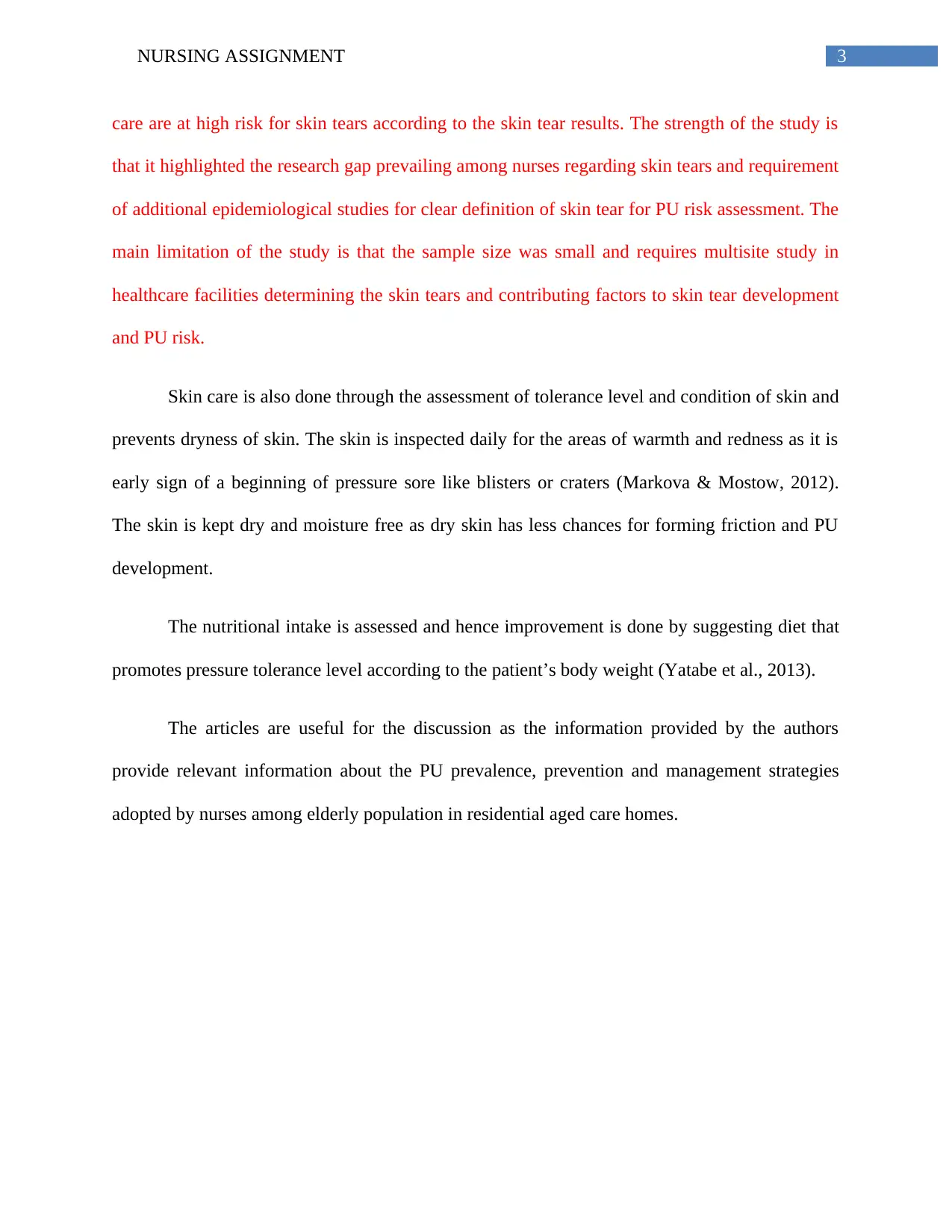
3NURSING ASSIGNMENT
care are at high risk for skin tears according to the skin tear results. The strength of the study is
that it highlighted the research gap prevailing among nurses regarding skin tears and requirement
of additional epidemiological studies for clear definition of skin tear for PU risk assessment. The
main limitation of the study is that the sample size was small and requires multisite study in
healthcare facilities determining the skin tears and contributing factors to skin tear development
and PU risk.
Skin care is also done through the assessment of tolerance level and condition of skin and
prevents dryness of skin. The skin is inspected daily for the areas of warmth and redness as it is
early sign of a beginning of pressure sore like blisters or craters (Markova & Mostow, 2012).
The skin is kept dry and moisture free as dry skin has less chances for forming friction and PU
development.
The nutritional intake is assessed and hence improvement is done by suggesting diet that
promotes pressure tolerance level according to the patient’s body weight (Yatabe et al., 2013).
The articles are useful for the discussion as the information provided by the authors
provide relevant information about the PU prevalence, prevention and management strategies
adopted by nurses among elderly population in residential aged care homes.
care are at high risk for skin tears according to the skin tear results. The strength of the study is
that it highlighted the research gap prevailing among nurses regarding skin tears and requirement
of additional epidemiological studies for clear definition of skin tear for PU risk assessment. The
main limitation of the study is that the sample size was small and requires multisite study in
healthcare facilities determining the skin tears and contributing factors to skin tear development
and PU risk.
Skin care is also done through the assessment of tolerance level and condition of skin and
prevents dryness of skin. The skin is inspected daily for the areas of warmth and redness as it is
early sign of a beginning of pressure sore like blisters or craters (Markova & Mostow, 2012).
The skin is kept dry and moisture free as dry skin has less chances for forming friction and PU
development.
The nutritional intake is assessed and hence improvement is done by suggesting diet that
promotes pressure tolerance level according to the patient’s body weight (Yatabe et al., 2013).
The articles are useful for the discussion as the information provided by the authors
provide relevant information about the PU prevalence, prevention and management strategies
adopted by nurses among elderly population in residential aged care homes.
Paraphrase This Document
Need a fresh take? Get an instant paraphrase of this document with our AI Paraphraser
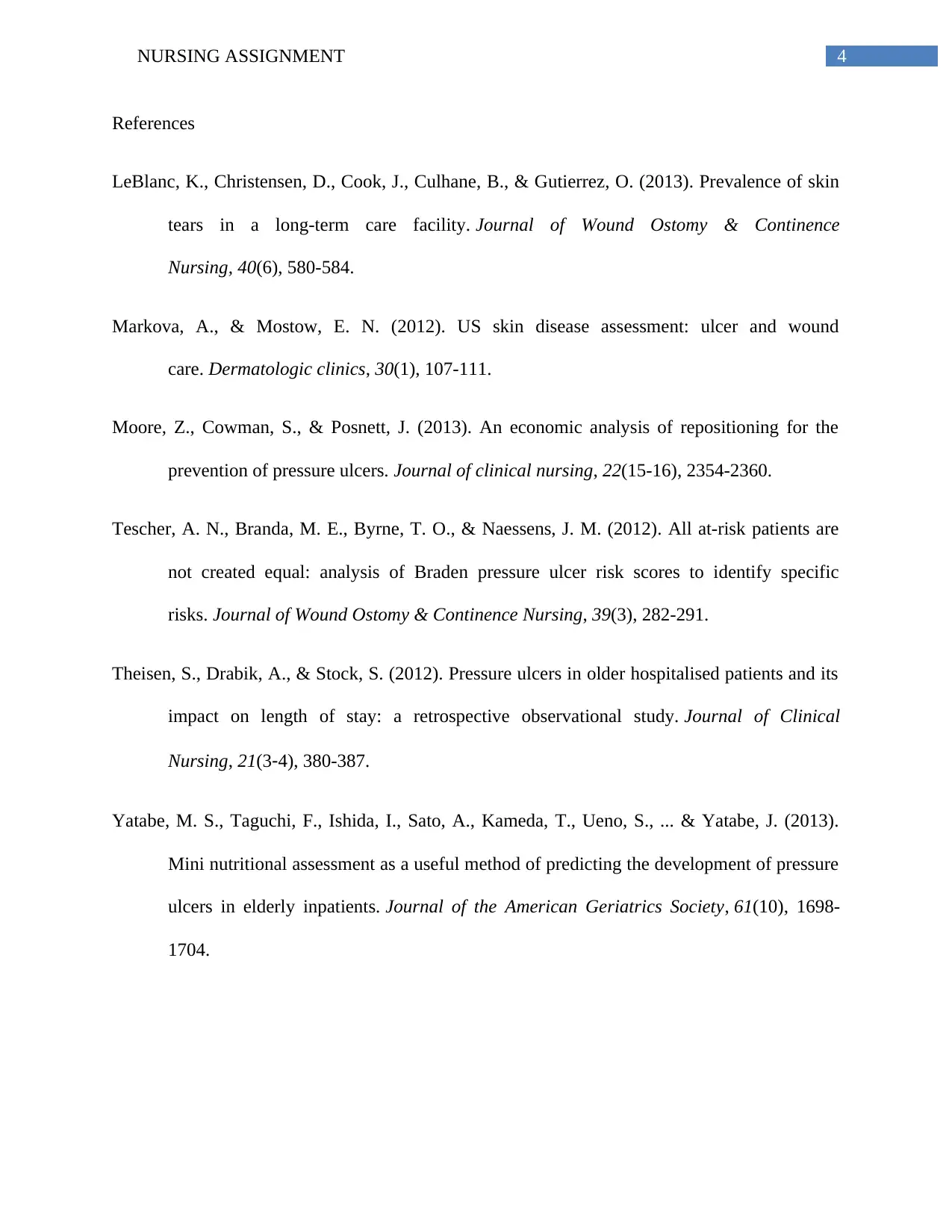
4NURSING ASSIGNMENT
References
LeBlanc, K., Christensen, D., Cook, J., Culhane, B., & Gutierrez, O. (2013). Prevalence of skin
tears in a long-term care facility. Journal of Wound Ostomy & Continence
Nursing, 40(6), 580-584.
Markova, A., & Mostow, E. N. (2012). US skin disease assessment: ulcer and wound
care. Dermatologic clinics, 30(1), 107-111.
Moore, Z., Cowman, S., & Posnett, J. (2013). An economic analysis of repositioning for the
prevention of pressure ulcers. Journal of clinical nursing, 22(15-16), 2354-2360.
Tescher, A. N., Branda, M. E., Byrne, T. O., & Naessens, J. M. (2012). All at-risk patients are
not created equal: analysis of Braden pressure ulcer risk scores to identify specific
risks. Journal of Wound Ostomy & Continence Nursing, 39(3), 282-291.
Theisen, S., Drabik, A., & Stock, S. (2012). Pressure ulcers in older hospitalised patients and its
impact on length of stay: a retrospective observational study. Journal of Clinical
Nursing, 21(3‐4), 380-387.
Yatabe, M. S., Taguchi, F., Ishida, I., Sato, A., Kameda, T., Ueno, S., ... & Yatabe, J. (2013).
Mini nutritional assessment as a useful method of predicting the development of pressure
ulcers in elderly inpatients. Journal of the American Geriatrics Society, 61(10), 1698-
1704.
References
LeBlanc, K., Christensen, D., Cook, J., Culhane, B., & Gutierrez, O. (2013). Prevalence of skin
tears in a long-term care facility. Journal of Wound Ostomy & Continence
Nursing, 40(6), 580-584.
Markova, A., & Mostow, E. N. (2012). US skin disease assessment: ulcer and wound
care. Dermatologic clinics, 30(1), 107-111.
Moore, Z., Cowman, S., & Posnett, J. (2013). An economic analysis of repositioning for the
prevention of pressure ulcers. Journal of clinical nursing, 22(15-16), 2354-2360.
Tescher, A. N., Branda, M. E., Byrne, T. O., & Naessens, J. M. (2012). All at-risk patients are
not created equal: analysis of Braden pressure ulcer risk scores to identify specific
risks. Journal of Wound Ostomy & Continence Nursing, 39(3), 282-291.
Theisen, S., Drabik, A., & Stock, S. (2012). Pressure ulcers in older hospitalised patients and its
impact on length of stay: a retrospective observational study. Journal of Clinical
Nursing, 21(3‐4), 380-387.
Yatabe, M. S., Taguchi, F., Ishida, I., Sato, A., Kameda, T., Ueno, S., ... & Yatabe, J. (2013).
Mini nutritional assessment as a useful method of predicting the development of pressure
ulcers in elderly inpatients. Journal of the American Geriatrics Society, 61(10), 1698-
1704.
1 out of 5
Related Documents
Your All-in-One AI-Powered Toolkit for Academic Success.
+13062052269
info@desklib.com
Available 24*7 on WhatsApp / Email
![[object Object]](/_next/static/media/star-bottom.7253800d.svg)
Unlock your academic potential
Copyright © 2020–2025 A2Z Services. All Rights Reserved. Developed and managed by ZUCOL.




